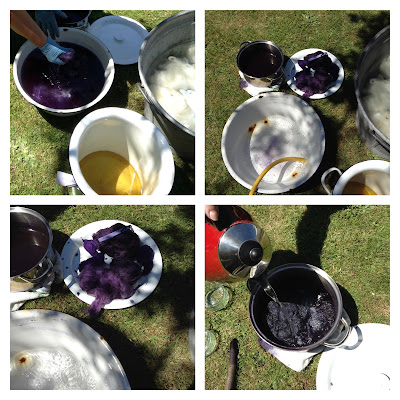 |
| Clockwise from top left: Natural wool skeins and fleece, Brewing up some eucalyptus leaves, and below, Pots of dye bubbling on the open fire pit |
My sister (Sue Wright Handknits) is a weaver, spinner and knitter who uses natural dyes to colour her hand spun yarns. Last week she invited me to come along to help out - and have a go myself. So I went armed with overalls, a big bag of home grown nettles (for dyeing) and some small pieces of muslin to make test pieces.
 |
| Logwood Natural Dye: A gorgeous purple. The bottom right picture is after adding iron to get a blue purple. |
Our first test was to bubble up my nettles in a pot. We stewed them for quite a while before straining the liquid off to use as our dye. Sue also stewed a batch of Eucalyptus leaves on the fire pit - which we thought would smell strongly of menthol, but didn't! These were our two home grown dye material sources, while the rest were natural dyes available from kits: like the gorgeous purple Logwood you can see in the photos above.
 |
| Brazilwood Natural Dye: vibrant salmon orange shades (on wool) and pale pinks on cloth. The bottom right photo is with the addition of iron - again adding bluer tones |
We got into a good routine with batches turning around regularly. Which meant there was barely enough time to admire the latest result before the next batch was ready to come off the fire, cool down and rinse.
The Logwood and the Brazilwood (above) we used twice to get two shades from each by adding iron to the second batch. As a potter this was a very interesting aspect to the dyeing process - how additions of iron can change the colour. What would we do without iron and its oxides?! In both cases there was a shift from the red tones in the colours to a bluer, cooler shade.
 |
| Natural Dye Results: gorgeous range of colours from 8 different batches |
What was also really interesting is how different the results were between the wool and the cloth. While Sue's skeins and fleece came out a vivid salmon colour using the Brazilwood, my muslin cloth was a pretty pale pink. Unfortunately my nettles only gave a slight change of colour - a very pale cream. Next time we'll add the stalks too! But the Eucalyptus was a good yellow response compared to the Natural Dye Fustic kit which was a much paler yellow.
 |
| Natural Dye Results: (top to bottom) Nettle, Eucalyptus, Fustic, Brazilwood (pink), Logwood (blue), Brazilwood with iron (lilac), Logwood (purple) |
Overall it was a lovely day with lots of interesting and inspiring colours. Above is a photo of all my scraps of muslin together. As everything we used was natural, the colour ranges go together really well. I had planned to make a handmade voile for the backdoor with all my pieces - but instead I've been using them to help 'style' my pots in a recent photoshoot. So you might see them around!
Thank you Sue!!!


I found this very interesting as i'm in a swap that dyes fabric squares, and I didn't have a clue how to start, now I do! Fabulous colours x
ReplyDeleteThanks Rosa! Glad it was useful! Jude.
Delete